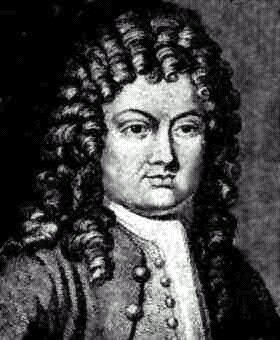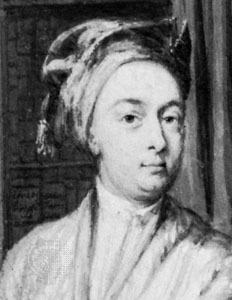<Back to Index>
- Mathematician Brook Taylor, 1685
- Composer Benjamin Louis Paul Godard, 1849
- Emperor of Austria Franz Joseph I, 1830


Brook Taylor FRS (18 August 1685 – 30 November 1731) was an English mathematician who is best known for Taylor's theorem and the Taylor series.
Brook Taylor was born in Edmonton (at that time in Middlesex) to John Taylor of Bifrons House, Kent, and Olivia Tempest, daughter of Sir Nicholas Tempest, Bart., of Durham. Brook entered St John's College, Cambridge, as a fellow-commoner in 1701, and took degrees of LL.B. and LL.D. in 1709 and 1714, respectively. Having studied mathematics under John Machin and John Keill, in 1708 he obtained a remarkable solution of the problem of the "centre of oscillation," which, however, remaining unpublished until May 1714 (Phil. Trans., vol. xxviii. p. x1), his claim to priority was unjustly disputed by Johann Bernoulli. Taylor's Methodus Incrementorum Directa et Inversa (1715) added a new branch to the higher mathematics, now designated the "calculus of finite differences." Among other ingenious applications, he used it to determine the form of movement of a vibrating string, by him first successfully reduced to mechanical principles. The same work contained the celebrated formula known as Taylor's theorem, the importance of which remained unrecognized until 1772, when J.L. Lagrange realized its powers and termed it "le principal fondement du calcul différentiel" ("the main foundation of differential calculus").
In his 1715 essay Linear Perspective, Taylor set forth the true principles of the art in an original and more general form than any of his predecessors; but the work suffered from the brevity and obscurity which affected most of his writings, and needed the elucidation bestowed on it in the treatises of Joshua Kirby (1754) and Daniel Fournier (1761).
Taylor was elected a fellow of the Royal Society early in 1712, and in the same year sat on the committee for adjudicating the claims of Sir Isaac Newton and Gottfried Leibniz, and acted as secretary to the society from 13 January 1714 to 21 October 1718. From 1715 his studies took a philosophical and religious bent. He corresponded, in that year, with the Comte de Montmort on the subject of Nicolas Malebranche's tenets; and unfinished treatises, On the Jewish Sacrifices and On the Lawfulness of Eating Blood, written on his return from Aix-la-Chapelle in 1719, were afterwards found among his papers. His marriage in 1721 with Miss Brydges of Wallington, Surrey, led to an estrangement from his father, which ended in 1723 after her death in giving birth to a son, who also died. The next two years were spent by him with his family at Bifrons, and in 1725 he married this time with his father's approval, Sabetta Sawbridge of Olantigh, Kent, who also died in childbirth in 1730 ; in this case, however, the child, a daughter, survived. Taylor's fragile health gave way; he fell into a decline, died at Somerset House, and was buried at St Ann's, Soho. By the date of his father's death in 1729 he had inherited the Bifrons estate. As a mathematician, he was the only Englishman after Sir Isaac Newton and Roger Cotes capable of holding his own with the Bernoullis, but a great part of the effect of his demonstrations was lost through his failure to express his ideas fully and clearly.
According to the Oxford Dictionary of National Biography, Taylor died "on 30 November 1731 in Somerset House, London. He was buried in London on 2 December 1731, near his first wife, in the churchyard of St Anne's, Soho."